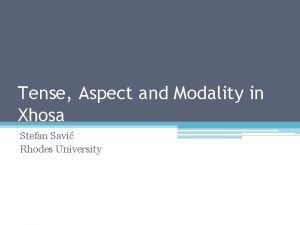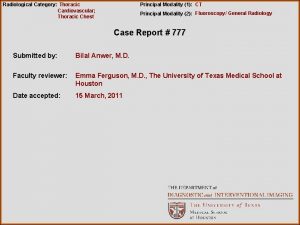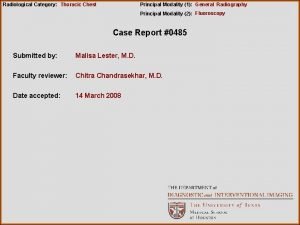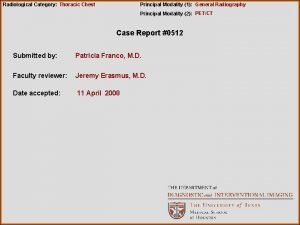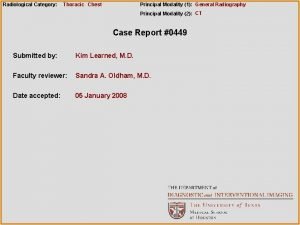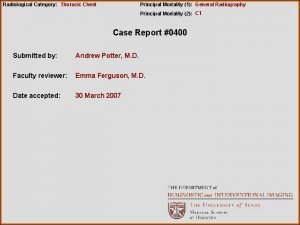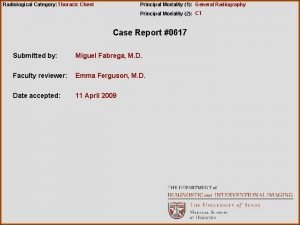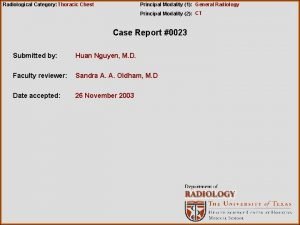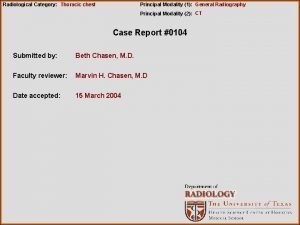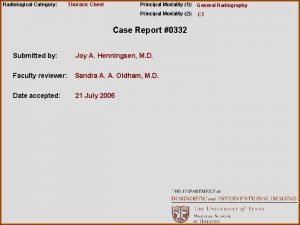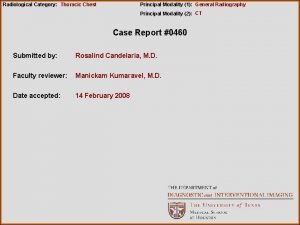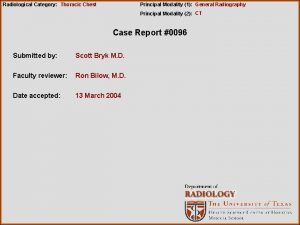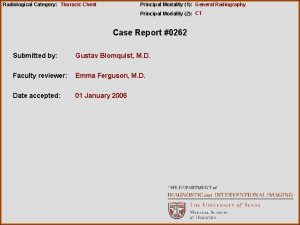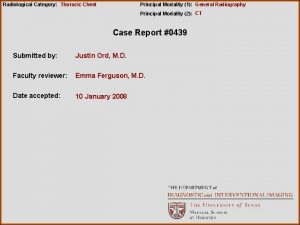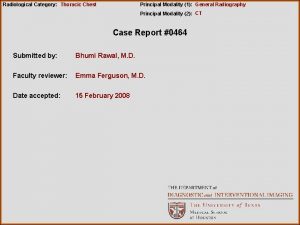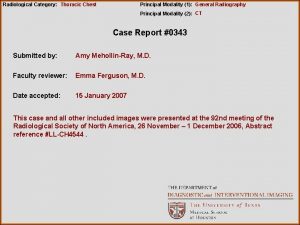Radiological Category Thoracic Chest Principal Modality 1 General

















- Slides: 17

Radiological Category: Thoracic Chest Principal Modality (1): General Radiography Principal Modality (2): CT Case Report #0606 Submitted by: Andrew Baugh, M. D. Faculty reviewer: Emma Ferguson , M. D. Date accepted: 15 March 2009

Case History 40 year old female with shortness of breath during and upon return from a ski trip.

Radiological Presentations

Radiological Presentations

Radiological Presentations

Radiological Presentations

Radiological Presentations

Radiological Presentations

Test Your Diagnosis Which one of the following is your choice for the appropriate diagnosis? After your selection, go to next page. • Pneumonia • High altitude pulmonary edema • Pleural effusion • Pulmonary embolism • Fibrosing mediastinitis • Pulmonary artery agenesis

Findings and Differentials Findings: Unilateral diffuse opacity Calcified hilar lymph nodes Differentials: • Pneumonia • High altitude pulmonary edema • Pleural effusion • Pulmonary embolism • Fibrosing mediastinitis • Pulmonary artery agenesis

Discussion This case demonstrates unilateral opacity (right lung) as well as calcified hilar lymph nodes (white arrows) and no visualized left pulmonary artery.

Discussion The VQ scan demonstrates patchy ventilation in the right lung, with normal perfusion of the left lung. The right lung perfusion is normal, with completely absent left lung perfusion.

Discussion 3 D reconstructive techniques well show the unilateral edema with an airspace rendering technique. A vascular view of the mediastinum shows calcified hilar nodes (white arrow) and paucity of vascularity.

Discussion High altitude pulmonary edema presents as dyspnea, cough, and reduced exercise performance 2 -5 days following arrival at high altitude (typically greater than 2500 meters). Further progression is marked by worsening symptoms, as well as development of a pink, frothy sputum. Clinical examination may show tachypnea, tachycardia, rales, and cyanosis. Altered mental status may occur with acute mental status, another presentation of high altitude illness.

Discussion Fibrosing mediastinitis is a rare disorder characterized by proliferation of acellular collagen and fibrous tissue within the mediastinum. Fibrosing mediastinitis is characterized by two forms, focal and diffuse. The focal type present with signs and symptoms related to obstruction of mediastinal, vascular, bronchopulmonary, or esophageal structures. Most cases are thought to be a histologic response to Histoplasma capulatum infection. Symptoms are variable and depend upon the structures involved. Structures more often involved include the central airways, superior vena cava, pulmonary veins, pulmonary arteries, and the esophagus. The most common presenting complaints are cough, dyspnea, recurrent pulmonary infection, hemoptysis, and pleuritic chest pain. Systemic signs, such as fever and weight loss, are less prevalent. Treatment for fibrosing mediastinitis has been attempted medically with systemic antifungals or corticosteroids. Other treatments include surgical therapy or local therapy for complications.

Diagnosis Fibrosing mediastinitis and high altitude pulmonary edema.

References Unilateral pulmonary edema due to pulmonary venous obstruction from fibrosing mediastinitis. C Rousti et. al, International Journal of Cardiology 108 (2006) 418 -421 Unilateral pulmonary vein stenosis secondary to idiopathic fibrosing mediastinitis. D P Leong, Heart 2008; 94: 776 Fibrosing Mediastinitis. S Rossi et al, Radio. Graphics 2001; 21: 737 -757 High Altitude-Induced Pulmonary Oedema, Maggiorini, M, Cardiovascular Research 72 (2006) 41 -50 High-Altitude Pulmmonary Edema: Current Concepts, Hultgran, H, Annu. Rev. Med. (1996) 47: 267 -84 Variable Radiomorphologic Data of High Altitude Pulmonary Edema. Features from 60 Patients. Vock, P et. al, Chest (1991) 100: 1306 -1311 High-Altitude Pulmonary Edema: Findings at High-Altitude Chest Radiography and Physical Examination. Vock, P et. al, Radiology (1989) 170: 661 -666
 Erate category 1
Erate category 1 National radiological emergency preparedness conference
National radiological emergency preparedness conference Radiological dispersal device
Radiological dispersal device Tennessee division of radiological health
Tennessee division of radiological health Center for devices and radiological health
Center for devices and radiological health Characteristics of sensory neurons
Characteristics of sensory neurons Sodality vs modality
Sodality vs modality Modality
Modality One to many relationship line
One to many relationship line Cardinality and modality
Cardinality and modality Cardinality and modality
Cardinality and modality Modality microsoft services
Modality microsoft services Epistemic modality
Epistemic modality Birads grading
Birads grading Modality stats
Modality stats Past tense in xhosa
Past tense in xhosa Modality in software engineering
Modality in software engineering Entity class in software engineering
Entity class in software engineering















